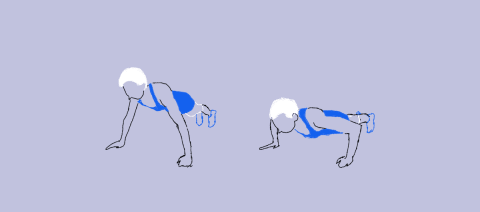But despite the less-than-stellar feelings that pushups can evoke, they’re actually good for us. There’s a reason this total-body move is a staple in many workouts, from HIIT to yoga to pure strength training. Here, we set the record straight on pushups, explaining the legitimate health benefits you’ll get from doing this move on the reg, how to actually do it correctly, tips for modifying the pushup to your fitness level, and more. “Pushups are a great upper-body strengthener,” says Stephanie Mansour, Chicago-based certified personal trainer. That’s because they work essentially your entire upper half, including the front of your chest, both the front and back of your arms (aka biceps and triceps), shoulders, and upper back, she explains. Building strength in these areas will make certain day-to-day activities—like carrying a hefty bag of groceries, or lifting a suitcase into an overhead bin—feel a little easier. Another perk: Compared to other upper-body moves that target just one specific muscle group—like bicep curls, for example, which home in on (surprise, surprise) your biceps—pushups hit many different muscle groups at once, making them an efficient, effective exercise for improving upper-body strength on the whole. A big part of that total-body work includes core strength and stability. When performed correctly, pushups are a great way to stabilize and strengthen your core, says Zetlin, who defines “core” as essentially all parts of your body that aren’t your heads, arms, or legs. That means the core isn’t just about your rectus abdominis (aka “abs”) but also includes many other muscles in your midsection. And while certain core moves focus primarily on the abs (looking at you, crunches), a properly performed pushup targets some of the lesser-known muscles in your core, like transverse abdominis (the deepest core muscle that helps supports your spine), multifidus (a series of small muscles that run along the spine), and others. By targeting these other core muscles, you’re helping the entire unit of your core become stronger and more stable. Because the core is essentially the powerhouse of the body and a crucial component of the movements we do in so many different scenarios, a stronger core unit will essentially make everything in life easier. That includes activities both at the gym (whether you’re squatting or running or lifting weights) and in day-to-day life (from walking or carrying groceries to picking up a child). Also on the topic of heart health: A 2019 study1 of 1,109 adult male firefighters found that baseline pushup ability may be associated with risk of cardiovascular problems. In the study, men who were able to bust out at least 40 pushups over 30 seconds had significantly lower risk of experiencing cardiovascular problems (think heart attack and heart failure) over the following decade compared with men who could do less than 10 pushups. Keep in mind that this study focused solely on male firefighters (a pretty niche population) and that the results don’t mean that pushups are your surefire ticket to good ticker health. But the results do suggest that your pushup abilities might predict your risk of developing cardiovascular problems. A proper pushup, he explains, involves engaging the scapula and rhomboids (two mid-back muscles that are typically underworked) without relying as much on the muscles on top of your shoulders and neck (which many of us typically overuse in day-to-day life anyway, especially when we’re stressed). Good posture also comes from quality core strength and stability, and as mentioned, pushups can definitely help with that. In terms of frequency, Zetlin suggests doing pushups one to three times a week. Though daily pushup challenges are popular, both he and Mansour aren’t big fans of doing pushups every day as that frequency likely won’t give your body the time it needs to properly rest and recover. Mansour suggests simply listening to your body to determine how often to do pushups—if yesterday’s set left you feeling sore, wait until that fatigue subsides before you get back at it. You can tackle pushups before a cardio workout or do them after weight lifting, says Zetlin. Or you can bust out sets of pushups as their own mini workout. Zetlin, however, isn’t a fan of pushups on your knees as he says it can stress the lower back, increase your likelihood of rounding your spine, and reduce the core challenge. As an alternative, he suggests simply holding the pushup starting position (aka a high plank) for 20 to 30 seconds at a time, keeping your heels together for added core challenge. Or, if you have limited mobility, joint issues, or otherwise aren’t ready for a high plank, you could try standing pushups performed against the wall, he adds. On the flip side, if you want to up the ante, there are many types of pushups that are more difficult. One suggestion: Place your toes atop an approximately 18-inch bench or a box so that your feet are higher than your hips, suggests Mansour. By performing pushups at this diagonal angle, you’ll increase the strength demands on your upper body and core. Here’s how to do that: Say, for instance, you’ve worked your way up to 30 consecutive pushups, and no matter how hard you try, you can’t seem to make it to 31. The next time you get to 30 pushups, lower yourself down and simply hold your form at the bottom of the movement for as long as possible without worrying about pushing yourself back up. This will help you build stability in your muscles and challenge your body in a new way so that you’ll ultimately be able to break through to the next level. “Stay with it,” says Zetlin. “You will continue to get better.” But if you can’t yet do a proper pushup, don’t stress. There are several simple ways you can build up your strength—no middle school gym class or tear-inducing bootcamp workouts required.



